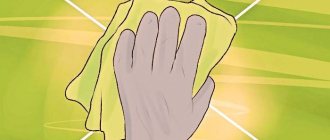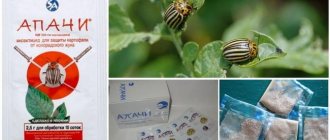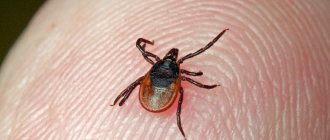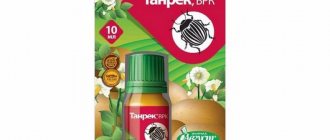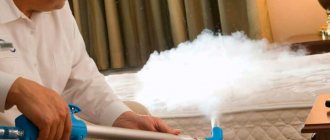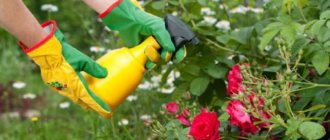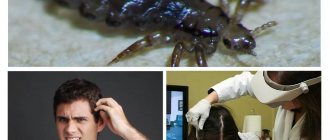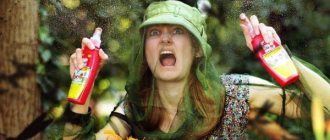Using copper sulfate against fungus on walls
When fighting fungus and mold, it is not necessary to use expensive special products, which are now quite plentiful in stores or on the market.
The disadvantage of using such products is toxicity, so after treatment the room needs to be ventilated for a long time, and it is better not to touch the treated surface, but this is difficult if there are children or pets in the house. If the area of the infected surface is not too large, then simpler, but no less reliable methods can be used to combat the fungus. One of the cheapest and simplest remedies is a solution of copper sulfate.
This drug can be used not only in an apartment or private house, but also in utility rooms - garages, sheds, attics.
Below we will talk about how to dilute copper sulfate, treat different surfaces with this product, and much more.
What is needed to remove mold using vitriol?
To prepare and apply the solution, we will need:
- Copper sulfate - 100 grams.
- Warm water - 10 liters. The container is ceramic or metal with an enameled surface.
- Vinegar - 200 ml (not necessary, but will enhance the effect).
If you need to treat a large area, then the water-vitriol ratio should remain approximately the same - 100 to 1. That is, for 20 liters of water you need 200 grams of vitriol, for 50 liters of water - 500 grams.
Copper sulfate packaging
Additionally you will need:
- Sponge, or brush, or spray bottle - for application.
- Spatula, metal brush (for cleaning the surface).
- Antiseptic soap.
- Sandpaper.
Means of protection:
- Latex gloves.
- Respirator.
- Glasses.
- Clothing must cover the entire body.
How to dilute vitriol against mold?
Now let's talk about how to dilute the solution.
Dissolve 100 g of vitriol in 10 liters of warm (approximately +40º) water. The solution can be stirred with any available piece of wood. The water temperature may be lower, but in warm water the vitriol will dissolve faster.
For convenience, you can dilute the product in 4-5 liters of water, and after dissolving it, add liquid to the full volume.
To enhance the effect, you can dilute the following in the solution:
- Vinegar (9%): 25-40 ml per 10 liters of water and 100 grams of vitriol.
- A few drops of tea tree oil.
- Any product containing chlorine.
Aqueous solution of copper sulfate
The prepared vitriol solution can be stored for up to 3 months (at room temperature), or up to 1 year if stored in a cool place. For storage, use tightly sealed ceramic or glass containers. You cannot store the solution in a metal container.
Surface preparation and work
Before using vitriol, you need to prepare the surface:
- If possible, ventilation of the room is ensured (windows are opened, hoods are turned on).
- On walls affected by mold, the decorative coating is removed. Removal of the coating is carried out depending on its type (wallpaper is torn off, plaster or paint is scraped off with a spatula).
- If spores penetrate deeply, the surface must be cleaned with sandpaper.
- Before using vitriol, it is recommended to wash the areas affected by the fungus with a soapy solution and then let them dry. This is especially useful if black mold has grown on the wall.
- Wear protective equipment.
- Prepare a solution of vitriol (how to dilute it is described in the paragraph above).
- Using a sponge (or brush, or spray bottle), apply the solution to the wall.
- Allow the surface to dry. Depending on the level of humidity in the room and the area of the treated area, this can take from 2-3 to 10-12 hours (on average - 4-5).
- If there was a lot of rot, or mold was on the wall for a long time, it is recommended to repeat the treatment 3-5 times.
- After the surface has completely dried, you can begin finishing.
Please note: it is possible to remove mold with this solution. However, if the cause of the rot is not eliminated, it is possible that after some time it will appear again, and repeated removal will be required.
Is vitriol dangerous, and what are the symptoms of poisoning?
First, about the dangers of copper sulfate (both in the form of granules and in the form of a ready-made aqueous solution):
- In case of contact with skin, there is no danger, but hygienic treatment is required (wash the solution with soap and water).
- Contact of the solution with the eyes may cause a burn. In this case, you should immediately rinse your eyes with plenty of water.
- Dosage that can lead to poisoning: 0.5 grams of powder in dry form and 11 mg/kg when inhaled.
- The lethal dosage is 45-125 grams (if swallowed dry). The exact figure depends on body weight, health status and age.
Stages of work
Symptoms of poisoning:
- nausea and vomiting;
- pain in the stomach;
- increased heart rate;
- general deterioration of health, weakness;
- allergic reaction;
- skin rashes, itching.
If these symptoms are felt when working with vitriol, you must:
- stop working immediately;
- if the work was carried out indoors and symptoms appeared due to inhalation of the substance, leave the room and ventilate it;
- seek medical help.
Copper sulfate poisoning is a rare occurrence. It is possible with:
- accidental or intentional ingestion (dry product or solution);
- prolonged stay without a respirator in an unventilated area in which the solution is used.
Precautionary measures
When preparing the solution
When diluting, it is recommended to use gloves and a respirator. Copper sulfate in its “dry” form does not generate dust and does not scatter, but protective equipment should still be used as a safety net.
When applying the solution
The rules are:
- The minimum set of protective equipment is a respirator, goggles and rubber gloves. Ideally, the entire body should be covered with clothing.
- When carrying out work in a room, it is necessary to ensure its ventilation (open windows and doors, turn on hoods in the kitchen and bathroom, if any, turn on air handling units).
- After completion of work, the room should be ventilated for 1-2 days.
How to use a Vist smoke bomb: instructions and rules
How to get rid of mold at home: a selection of 12 folk remedies
Related Posts
The danger of fungus and mold in living spaces
The main danger of mold and mildew indoors is in spores that begin to spread in the air, settle on people’s skin, and enter the body through breathing, where they can be the source of many diseases.
Such diseases may include:
- rashes on the skin;
- eczema;
- dermatitis;
- damage to hair and nails;
- allergic rhinitis;
- cough;
- allergic conjunctivitis;
- musculoskeletal disorders;
- cause problems in the digestive system;
- if it gets into the blood, it can cause intoxication of the body;
- disturbances in the functioning of the genitourinary system.
And if in adults such diseases can be mild, then in children (especially those with weakened immune systems) all of the above diseases can be more severe and also cause serious complications. Therefore, you should get rid of fungus in your apartment as quickly as possible.
The use of copper sulfate against fungus and mold: effectiveness
Copper sulfate has long been used against pests and many pathogens in the garden. It is also effective in combating most fungi, including those that can appear on the walls of residential and non-residential premises.
The effectiveness of using such a solution has been tested for years - after the treatment procedure, the fungus disappears for a long time, only the solution of copper sulfate should be prepared in the appropriate concentration.
Important. Too low a concentration of copper sulfate may not give a positive result, so the main thing when fighting mold is to prepare the solution correctly.
What does the term “fungus” mean and its habitat?
Molds are such simple and at the same time complex creatures, they can take root in almost any conditions, reproduce well, and as a result of their vital activity, spores appear that have a destructive effect on any organic matter.
Please note: the ideal environment for fungal development is:
- environment with air temperature from 21 to 30°C;
- poor ventilation;
- dirt and high humidity.
Molds multiply very well where there are damp and thin walls that freeze in winter, where water constantly flows.
In an ordinary apartment, the fungus can be seen in the form of a dark greenish or black coating, which appears not only on the walls, but also on furniture, carpeting and even on indoor plants and has a not very pleasant smell.
The fungus is most active in spring and autumn.
There is an opinion that mold appears in old houses, the so-called “Khrushchev” apartments, where the panel walls are very thin and absorb moisture well.
Please note: the fungus has adapted to its life activity in modern homes. The cause of this common problem was innovative construction technologies - plastic windows.
It would seem that there is excellent sound insulation and great heat savings, but one bad drawback negates these advantages - poor ventilation. Air does not pass through such windows well and contributes to the formation of fungus. He finds refuge in secluded corners and begins his life.
How is surface treatment performed?
Specific processing options are used for different surface types. Depending on the density, type and density of the materials being processed, certain processing variations are used.
Trees
Treating wooden surfaces against fungus is carried out as follows:
- clean the affected surface with sandpaper to remove fungus from the surface;
- then you should wipe the wooden surfaces with soapy water;
- after the boards have dried, they are treated with a solution of copper sulfate. The solution is prepared in the following proportion: 100 g of the drug is diluted in a bucket of warm water.
Metal
It is better not to treat metal surfaces with copper sulfate solution.
Most often in industry, metals are used that are cheaper than copper in a number of electrochemical potentials. Therefore, when copper sulfate gets on a metal surface, a chemical reaction occurs in which copper is replaced by metal, as a result it disappears.
Drywall
If the fungus has settled on the surface of the drywall, then remove the layer of plaster applied to the drywall with a metal spatula. Around the area affected by the fungus, you can treat it with copper sulfate.
If mold has penetrated inside a sheet of this material, then it is better to replace such a sheet, since in this case it will not be possible to defeat the mold - it is cheaper to replace the sheet.
Concrete and brick
Concrete and brick are cleaned of wallpaper affected by fungus. They cannot be used in the future; they must be destroyed immediately. Then the plaster is removed from the walls, as there are also traces of mold on it. Then they sand the walls to destroy even the mold that is not visible.
Then you can begin applying the copper sulfate solution. This can be done with a sponge or a special sprayer.
Surface preparation
Before treating walls with copper sulfate, it is necessary to prepare the surface. This should be done as follows:
- We are looking for the source of the spread of mold (mycelium). It may be located in hard-to-reach, inconspicuous places (for example, behind tiles). During the search, we tap the tiles. Each hollow area is one of the probable areas where the mycelium is located.
- We remove wallpaper, tiles or other finishing material from the walls.
- Use a spatula or a stiff brush to clean the surface. Then we carry out another cleaning - this time with fine-grained sandpaper.
- We treat the surface with soapy water and let it dry. In the end, you need to get a perfectly clean and dry surface.
Safety rules: important requirements
Basic safety measures when treating walls with copper sulfate:
- During processing, hands should be protected with rubber gloves;
- wear protective goggles over your eyes to protect them from splashes of the solution;
- the nasopharynx should be protected with a respirator;
- During processing, the ventilation in the room should be good, and the windows should also be opened;
- After treatment, clothes are washed and hung to dry on the balcony.
Repeated treatments
Usually, a couple of treatments of the walls with copper sulfate are carried out (the second - a few hours after the first). If necessary, if the damage to the walls is too severe, then the number of repeated treatments can be carried out up to 5 times (but no more).
Using copper sulfate to combat mold indoors is an effective measure if the damage is not too large. But it should be remembered that treating walls with copper sulfate solution is a rather lengthy undertaking.
We remove water and rust stains on the ceiling and walls with our own hands
- Remove wallpaper or wash off whitewash from a contaminated surface, and clean the putty down to the plaster or drywall.
- If the surface is painted, soak the stain with a damp sponge and remove the paint and putty with a spatula.
- Pour white into a plastic bowl and soak a sponge or piece of foam rubber in it.
- Treat the entire cleaned surface by squeezing out the sponge and pressing it firmly against the stain for a while. If the stain is larger than a sponge, then perform the treatment in several passes, soaking area by area. In this way, wet the entire stain. Continue the procedure until the yellow spot lightens.
- Wait for the treated surface to dry completely. If after drying the stain is not completely lightened, repeat the operation again. Instead of whiteness, you can use other solutions and pastes described below.
- Prime the treated area with deep penetration acrylic primer using a roller and brush and let it dry for 24 hours.
- Paint the primed surface with oil paint in several layers and let it dry.
- Prime the entire surface with acrylic primer and let it dry for 24 hours.
- Cover the surface with a layer of acrylic putty and dry for at least a day.
- Sand the putty with fine sandpaper (180-200), especially carefully go through the transition points from the new to the old surface and prime the surface again.
- After complete drying, paint the repaired area with the same paint that was used to paint the ceiling or walls.
- Repaint the entire ceiling or wall again with your base paint.
- If you decide to apply another decorative coating or wallpaper, then you do not need to do the two previous steps.
